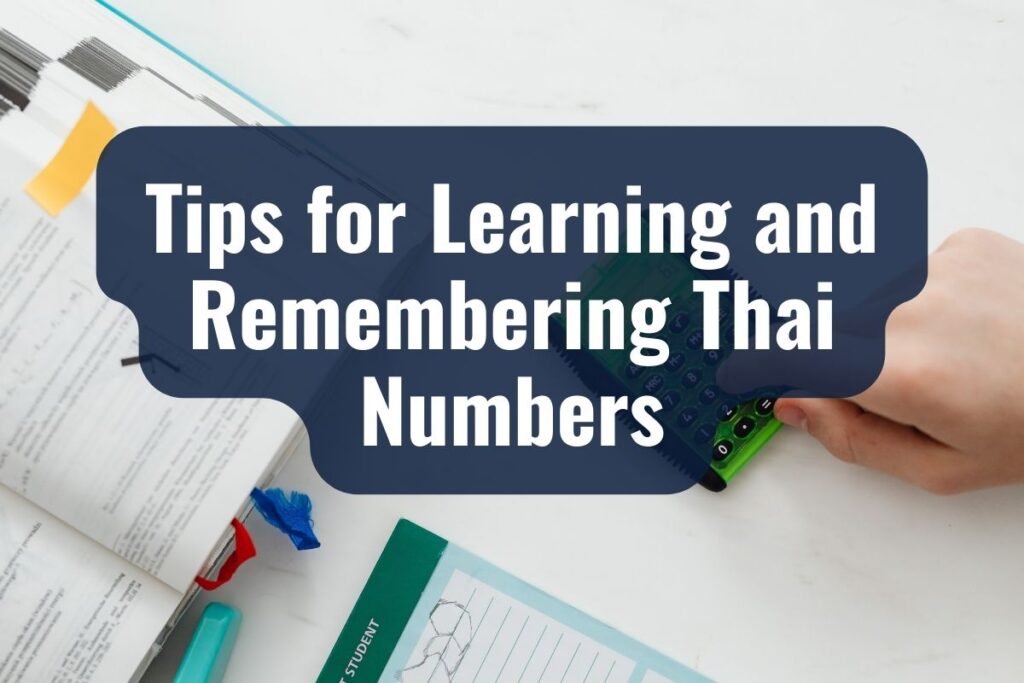Thai might seem challenging at first, especially with its unique script and pronunciation, but with consistent practice, you’ll find yourself counting in Thai more naturally and confidently.
Whether you are in Thailand for a short visit, a long-term stay, or even if you’re just curious about the language, knowing how to count in Thai is essential. This skill will not only enhance your daily interactions in local markets, restaurants, and with new friends but also deepen your appreciation of Thai culture.
KEY TAKEAWAYS
- Thai numbers use a logical decimal system, similar to Western numerals.
- Basic Thai numbers (1-10) are foundational for understanding larger numbers.
- Numbers beyond 10 in Thai are formed by combining basic numbers with tens.
- Thai numbers are essential for practical daily activities like shopping and travel.
- Hundreds and thousands in Thai follow a simple pattern of combination.
Basic Thai Numbers (1-10)

Starting with the Basics: 1 to 10
Embarking on your journey to learn Thai numbers, we begin with the foundation: numbers one through ten. These are the building blocks for all other numbers you will encounter, and getting familiar with these is crucial. Below, you will find each number listed with its Thai script, English transliteration, and a phonetic guide to help with pronunciation.
| Number (English) | Thai Script | Transliteration | Phonetic Pronunciation |
| 1 | หนึ่ง | nùeng | “nung” |
| 2 | สอง | sǎawng | “sa-ong” |
| 3 | สาม | sǎam | “saam” |
| 4 | สี่ | sìi | “see” |
| 5 | ห้า | hâa | “ha” |
| 6 | หก | hòk | “hok” |
| 7 | เจ็ด | jèt | “jet” |
| 8 | แปด | bpàet | “paet” |
| 9 | เก้า | gâo | “gao” |
| 10 | สิบ | sìp | “sip” |
The Numbers One to Ten in Thai
- หนึ่ง (nùeng) – pronounced like “nung”
- สอง (sǎawng) – pronounced like “sa-ong”
- สาม (sǎam) – pronounced like “saam”
- สี่ (sìi) – pronounced like “see”
- ห้า (hâa) – pronounced like “ha”
- หก (hòk) – pronounced like “hok”
- เจ็ด (jèt) – pronounced like “jet”
- แปด (bpàet) – pronounced like “paet”
- เก้า (gâo) – pronounced like “gao”
- สิบ (sìp) – pronounced like “sip”
Practicing Pronunciation
The Thai language has unique tones and pronunciations, which might be unfamiliar at first. It is crucial to listen to these numbers being spoken, ideally by a native speaker, to understand their correct pronunciation. You can find numerous resources online, like language learning apps or websites, which provide audio pronunciations.
Visualizing Thai Numbers
To aid your learning, it’s helpful to associate each number with its Thai script. Visual recognition of these numbers can be as crucial as their pronunciation, especially when you encounter them in written form in Thailand. You might see them on street signs, in markets, or on menus. Recognizing these basic numbers in Thai script will greatly enhance your ability to navigate daily life in Thailand.
Consistent Practice
As with any language skill, regular practice is key. Try to incorporate these numbers into your daily routine. Count objects around you, practice saying the numbers out loud, or even write them down to familiarize yourself with their script. Engaging with the numbers in these simple ways will help solidify your understanding and recall.
Counting Beyond 10: The Basics (11-100)
Now that you’re familiar with the numbers one to ten in Thai, it’s time to extend your knowledge further. Counting from 11 to 100 in Thai follows a logical and systematic pattern, much like the decimal system you’re used to. Understanding these patterns will not only help you count but also assist in various everyday situations like shopping, traveling, and scheduling.
The Structure of Thai Numbers from 11-100
The Thai language forms numbers beyond ten by combining the words for ten (สิบ sìp) with other numbers. Let’s break this down:
11-19: The Teen Numbers
In Thai, numbers 11 to 19 are formed by starting with the word for ten (สิบ sìp) and then adding the numbers one to nine. For example, eleven in Thai is สิบเอ็ด (sìp èt), literally ‘ten one’. Note that 11 (sìp èt) is an exception where เอ็ด (èt) is used instead of หนึ่ง (nùeng) for one.
20-99: The Tens and Units
For numbers 20 and above, you say the multiple of ten (like twenty, thirty, etc.) followed by the unit number. For example, 21 is ยี่สิบเอ็ด (yîi sìp èt), which translates to ‘two-ten-one’. Here, ยี่ (yîi) is used for two in compound numbers instead of สอง (sǎawng).
A Quick Guide to Tens in Thai
- 20: ยี่สิบ (yîi sìp)
- 30: สามสิบ (sǎam sìp)
- 40: สี่สิบ (sìi sìp)
- 50: ห้าสิบ (hâa sìp)
- 60: หกสิบ (hòk sìp)
- 70: เจ็ดสิบ (jèt sìp)
- 80: แปดสิบ (bpàet sìp)
- 90: เก้าสิบ (gâo sìp)
Practice with Examples
- 22: ยี่สิบสอง (yîi sìp sǎawng) – ‘two-ten-two’
- 35: สามสิบห้า (sǎam sìp hâa) – ‘three-ten-five’
- 47: สี่สิบเจ็ด (sìi sìp jèt) – ‘four-ten-seven’
- 59: ห้าสิบเก้า (hâa sìp gâo) – ‘five-ten-nine’
Tips for Learning
- Practice Regularly: Try forming different numbers using this structure. Practice saying them out loud or writing them down.
- Listen to Native Speakers: Pay attention to how native Thai speakers pronounce these numbers, especially regarding the tones.
- Use Real-life Situations: Practice these numbers in real-life scenarios, like when you’re at a market or reading addresses.
How to Count in Thai: In Hundreds and Thousands
As you become more comfortable with smaller numbers, expanding your range to include hundreds and thousands is the next step. This expansion is crucial for understanding larger quantities, prices, distances, and even dates in Thai. The Thai language follows a simple and logical pattern for forming these larger numbers, similar to the earlier patterns you’ve learned.
The Structure of Hundreds in Thai
Basic Hundreds
The word for ‘hundred’ in Thai is ร้อย (rɔ́ɔi). To form multiples of hundreds, simply place the number (1-9) before ร้อย. For example:
- 100: หนึ่งร้อย (nùeng rɔ́ɔi) – ‘one hundred’
- 200: สองร้อย (sǎawng rɔ́ɔi) – ‘two hundred’
- 300: สามร้อย (sǎam rɔ́ɔi) – ‘three hundred’, and so on.
Combining Hundreds with Tens and Units
For numbers like 125 or 364, combine the hundreds, tens, and units as you’ve learned. For example:
- 125: หนึ่งร้อยยี่สิบห้า (nùeng rɔ́ɔi yîi sìp hâa) – ‘one hundred two-ten-five’
- 364: สามร้อยหกสิบสี่ (sǎam rɔ́ɔi hòk sìp sìi) – ‘three hundred six-ten-four’
The Structure of Thousands in Thai
Basic Thousands
The word for ‘thousand’ in Thai is พัน (phan). Similar to hundreds, you place the numeral before พัน. For example:
- 1000: หนึ่งพัน (nùeng phan) – ‘one thousand’
- 2000: สองพัน (sǎawng phan) – ‘two thousand’
- 3000: สามพัน (sǎam phan) – ‘three thousand’, and so on.
Combining Thousands with Hundreds, Tens, and Units
For larger numbers, the same pattern of combination applies. For example:
- 4521: สี่พันห้าร้อยยี่สิบเอ็ด (sìi phan hâa rɔ́ɔi yîi sìp èt) – ‘four thousand five hundred two-ten-one’
- 7863: เจ็ดพันแปดร้อยหกสิบสาม (jèt phan bpàet rɔ́ɔi hòk sìp sǎam) – ‘seven thousand eight hundred six-ten-three’
Tips for Mastering Larger Numbers
- Practice in Context: Try to find opportunities to read and use these numbers in real life, like when discussing prices, distances, or quantities.
- Break It Down: When encountering a large number, break it down into its components (thousands, hundreds, tens, and units) to understand and pronounce it better.
- Use Visual Aids: Write down large numbers in both Thai script and Arabic numerals to reinforce your learning visually.
Building Confidence with Bigger Numbers
Learning to count in hundreds and thousands in Thai is a significant step in mastering the language’s numerical system. It opens up new possibilities for understanding and engaging with the world around you in Thailand. Keep practicing these larger
The Thai Numeral System
Before diving into the numbers themselves, it’s essential to grasp the basics of the Thai numeral system. This system is deeply rooted in Thailand’s rich history and culture, reflecting the uniqueness of the Thai language. It’s fascinating to note that, like many other languages, Thai employs a decimal (base-10) system for its numerals. This means that it operates on powers of ten, which is a familiar concept for those accustomed to Western numbering systems.
The Thai Numerals: A Blend of Tradition and Modernity
Thai numerals have their own distinct characters, different from the Arabic numerals used in Western cultures. This distinction adds a layer of cultural depth and tradition to learning Thai numbers. While in contemporary Thailand, Arabic numerals are commonly used in many contexts, traditional Thai numerals still hold their place, especially in formal, cultural, and historical settings.
As a learner, familiarizing yourself with both sets of numerals can enrich your understanding and experience of Thai culture.
Decimal System: A Familiar Concept
For those familiar with the Western numbering system, the decimal structure of Thai numbers offers a sense of familiarity. Each Thai number is built up from units, tens, hundreds, and so on, just like in Western numerals. This similarity provides a foundation that makes learning Thai numbers more approachable for foreigners.
The Role of Thai Numbers in Daily Life
In Thailand, numbers play a crucial role in everyday life. From street addresses to prices, phone numbers, and even dates, numbers are omnipresent. Mastering the basics of the Thai numeral system not only assists in practical situations but also shows respect and appreciation for the Thai culture. It’s a gesture that’s often appreciated by locals, enhancing your interactions and experiences in the country.
Moving Forward with Confidence
As you become more comfortable with these numbers, you will find it easier to navigate many everyday situations in Thailand. Remember, practice and exposure are key. In the next section, we will tackle larger numbers, venturing into hundreds and thousands, further expanding your Thai numeral vocabulary. Keep practicing, and you’ll soon find that counting in Thai becomes a natural part of your language skill set.
Practical Applications: Using Numbers in Daily Life

Integrating Thai Numbers into Everyday Situations
Mastering the basics of Thai numbers is more than just a linguistic achievement; it’s a practical tool that can significantly enhance your everyday experiences in Thailand. Let’s explore how you can apply your newfound knowledge of Thai numbers in various common scenarios.
1. Shopping and Bargaining
Marketplace Transactions: One of the most frequent uses of numbers is while shopping, especially in local markets where prices are often not displayed. Understanding numbers can help you ask for prices (ราคาเท่าไหร่ raa-khaa thâo-rài?) and even bargain effectively.
Supermarkets and Malls: Even in modern shopping centers where prices are labeled, often in Arabic numerals, it’s helpful to understand when cashiers or salespeople mention prices or discounts in Thai.
2. Dining Out
Ordering Food: When ordering food, you’ll often need to specify quantities (e.g., สองแก้ว sǎawng gâew for ‘two drinks’).
Understanding the Bill: It’s common for bills in local eateries to be handwritten with Thai numerals. Recognizing these numbers helps ensure you’re paying the correct amount.
3. Using Public Transportation
Bus Numbers and Routes: Local buses typically have their routes and numbers displayed in Thai. Knowing numbers can help you catch the right bus.
Train and Subway Stations: Many stations are numbered, and announcements often include numbers in Thai.
4. Time and Scheduling
Telling Time: Although digital clocks are widespread, understanding spoken time in Thai is essential, especially when making appointments or reservations.
Dates and Days: Dates are often said in Thai, so knowing numbers helps in planning and understanding when events are scheduled.
5. Social Interactions
Exchanging Phone Numbers: Sharing or asking for a phone number is a common aspect of social interactions, and knowing Thai numbers makes this process smoother.
In Casual Conversations: Numbers often come up in everyday conversations, like discussing distances, ages, or quantities.
Making the Most of Your Number Skills
- Practice in Real-life Contexts: Try to use Thai numbers in your daily interactions. This not only reinforces your learning but also shows respect for the local culture.
- Learn to Listen: Pay attention to how numbers are used in everyday speech around you, like in markets, on public transport, or in restaurants.
- Ask for Help: Don’t hesitate to ask local friends or colleagues to help you practice or correct your pronunciation.
Embracing the Learning Journey
Remember, it’s okay to make mistakes as you learn. The key is to keep practicing and using numbers in your daily life. Every interaction is an opportunity to improve and become more confident in using Thai numbers. In the next section, we will advance to counting in hundreds and thousands, further enhancing your ability to navigate life in Thailand with ease.
Tips for Learning and Remembering Thai Numbers

Strategies for Effective Learning
Learning a new numerical system in a different language can be challenging, but with the right strategies, it becomes an achievable and rewarding endeavor. Here are some tips to help you learn and remember Thai numbers more effectively:
1. Use Mnemonics and Associations
- Create Associations: Link numbers with words, objects, or concepts that are familiar to you. For instance, associate ห้า (hâa – five) with a hand (having five fingers).
- Mnemonic Devices: Develop creative mnemonics to remember the sounds and shapes of Thai numbers. For example, สี่ (sìi – four) might be remembered by thinking of ‘four seas’.
2. Practice with Flashcards
- Visual Reinforcement: Create flashcards with Thai numbers on one side and their English counterparts on the other. This can help in memorizing both the Thai script and the pronunciation.
- Regular Review: Spend a few minutes each day reviewing these flashcards. The repetition will help cement the numbers in your memory.
3. Engage in Active Listening
- Listen to Thai Speakers: Regular exposure to native Thai speakers, whether through movies, songs, or conversations, can significantly improve your understanding and pronunciation of numbers.
- Audio Language Resources: Use language learning apps or online resources that offer audio playback of Thai numbers.
4. Practice Speaking Out Loud
- Regular Speaking Practice: Say the numbers out loud whenever you can. Practice counting objects, narrating time, or even reading out numbers from signs or menus in Thai.
- Language Exchange: Engage in language exchange with a Thai speaker. Practicing with a native speaker can greatly enhance your pronunciation and recall.
5. Incorporate Numbers into Daily Life
- Use Numbers in Real-Life Situations: Apply your knowledge of Thai numbers in daily activities, like shopping, asking for directions, or discussing prices.
- Challenge Yourself: Set small daily challenges, like only using Thai numbers when looking at the time or counting steps during a walk.
6. Be Consistent and Patient
- Regular Practice: Consistency is key in language learning. Incorporate a little practice into your daily routine.
- Patience with Progress: Remember that learning a new language takes time. Celebrate small victories and be patient with yourself.
Enhancing Retention and Fluency
Implementing these strategies will not only aid in learning Thai numbers but also enhance your overall fluency in the language. As you become more familiar with the numbers, you’ll find that they start to come to you more naturally, making your interactions in Thailand more seamless and rewarding. Keep practicing, stay curious, and enjoy the journey of learning Thai numbers!
Common Mistakes and How to Avoid Them
When learning to count in Thai, it’s natural to encounter some hurdles. Understanding these common mistakes and knowing how to avoid them can significantly smoothen your learning journey. Let’s explore some of these typical errors and how to tackle them effectively.
Mispronouncing Numbers
Issue: Thai is a tonal language, and incorrect tones can change the meaning of a word. Mispronouncing numbers, especially the tones, is a common mistake.
Solution: Listen to native speakers and practice mimicking their pronunciation. Pay special attention to the tones and try to replicate them accurately.
Confusing Similar-Sounding Numbers
Issue: Some numbers in Thai sound quite similar to each other, like เจ็ด (jèt – seven) and เก้า (gâo – nine).
Solution: Practice saying these numbers in different contexts. Use audio resources to hear the subtle differences clearly and repeatedly.
Mixing Up the Thai and Western Numeral Systems
Issue: Switching between Thai and Western numerals can sometimes be confusing, especially in written form.
Solution: Familiarize yourself with both numeral systems. Practice reading and writing numbers in Thai script to reinforce your understanding.
Misusing ยี่ (yîi) and สอง (sǎawng) for ‘Two’
Issue: In Thai, ยี่ (yîi) is used instead of สอง (sǎawng) in compound numbers (like 20, 200, etc.).
Solution: Remember the specific context in which ยี่ is used (e.g., ยี่สิบ yîi sìp for twenty). Regular practice and usage in context will help solidify this rule.
Forgetting the Special Form for ‘Eleven’
Issue: Eleven in Thai is เอ็ด (èt), not หนึ่ง (nùeng), which is a common mistake.
Solution: Memorize this exception and practice using it in various contexts to reinforce the correct form.
Overlooking the Contextual Use of Numbers
Issue: Numbers can have different forms or usages depending on the context, like telling time, dates, or counting objects.
Solution: Learn the numbers within various contexts. Practice with exercises that use numbers in different scenarios, such as time-telling, shopping, or date-setting.
Building Confidence Through Awareness
Being aware of these common mistakes and actively working to avoid them will greatly enhance your proficiency in using Thai numbers. Remember, making mistakes is a part of the learning process. Each error provides an opportunity to improve and learn. With continuous practice and a mindful approach, you’ll soon find yourself using Thai numbers with much more confidence and accuracy. Keep practicing, and enjoy the rewarding journey of learning a new language!
Related: How to be polite in Thailand
Additional Resources
- Thai Language Apps: Apps like ThaiPod101, Learn Thai from a White Guy, or Simply Learn Thai offer structured lessons, including numbers and pronunciation guides.
- General Language Apps: Duolingo, Babbel, and Rosetta Stone also offer Thai language courses that can help reinforce your numerical skills along with overall language proficiency.
- YouTube Channels: YouTube hosts numerous channels dedicated to Thai language learning. Channels like Learn Thai with Mod, ThaiPod101, or Speak Thai offer interactive and engaging video lessons focusing on numbers and everyday language.
- Online Courses: Websites like Udemy or Coursera may offer specific courses in Thai language that cover numbers and basic communication.
- Language Exchange Platforms: Websites like Tandem or HelloTalk connect you with native Thai speakers for language exchange. Practicing with a native speaker can significantly improve your pronunciation and understanding of nuances.
- Thai Cultural Groups: Engage with local Thai cultural groups or communities in your area. They often host language workshops or cultural events where you can practice Thai.
- Thai Language Books: Books such as “Thai for Beginners” by Benjawan Poomsan Becker or “Thai Reference Grammar” offer comprehensive insights into Thai numbers and overall language structure.
- Workbooks and Practice Sheets: Workbooks specifically designed for Thai language learning can provide exercises and practice materials for numbers.
- Custom Flashcards: Create or purchase flashcards focused on Thai numbers for regular practice.
- Language Learning Games: Look for educational games and puzzles that include Thai numbers, which can make learning more enjoyable and interactive.
- Thai Language Podcasts: Podcasts can be a great way to immerse yourself in the language, with episodes often dedicated to numbers and basic phrases.
- Audio Dictionaries and Pronunciation Guides: Audio-based resources can help you master the correct pronunciation and intonation of Thai numbers.


